The Crucial MX300 750GB SSD Review: Micron's 3D NAND Arrives
by Billy Tallis on June 14, 2016 9:00 AM ESTSequential Read Performance
The sequential read test requests 128kB blocks and tests queue depths ranging from 1 to 32. The queue depth is doubled every three minutes, for a total test duration of 18 minutes. The test spans the entire drive, and the drive is filled before the test begins. The primary score we report is an average of performances at queue depths 1, 2 and 4, as client usage typically consists mostly of low queue depth operations.
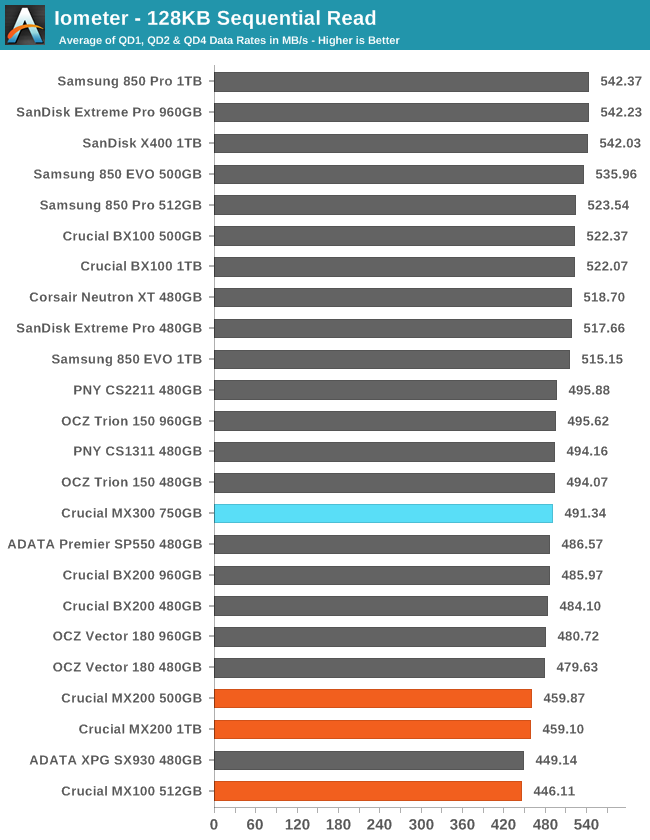
The earlier MX series drives had somewhat poor sequential read speeds, though the spread from best to worst is quite small. The MX300 brings things up to average.
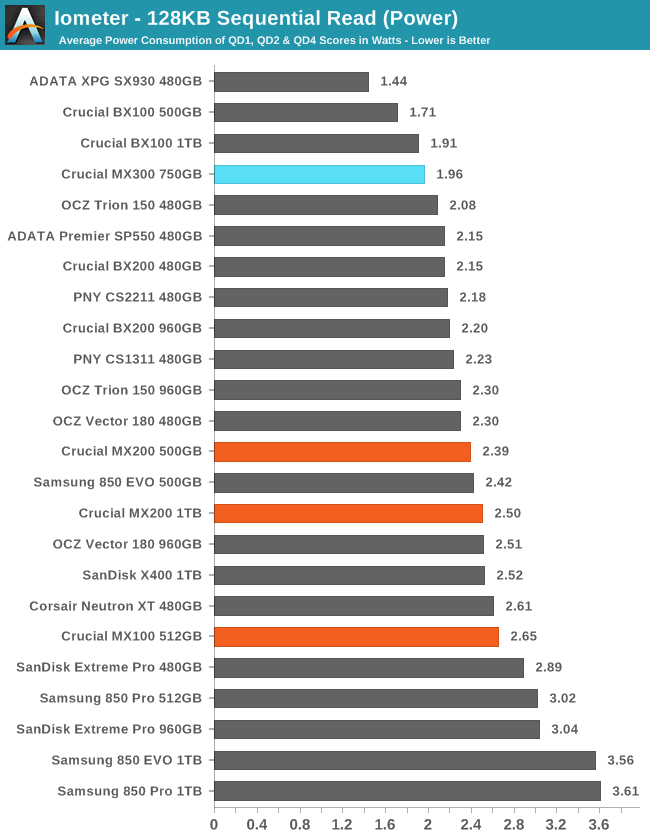
The MX300 is still quite efficient, but the SX930 and BX100 500GB both beat it by a wide margin.
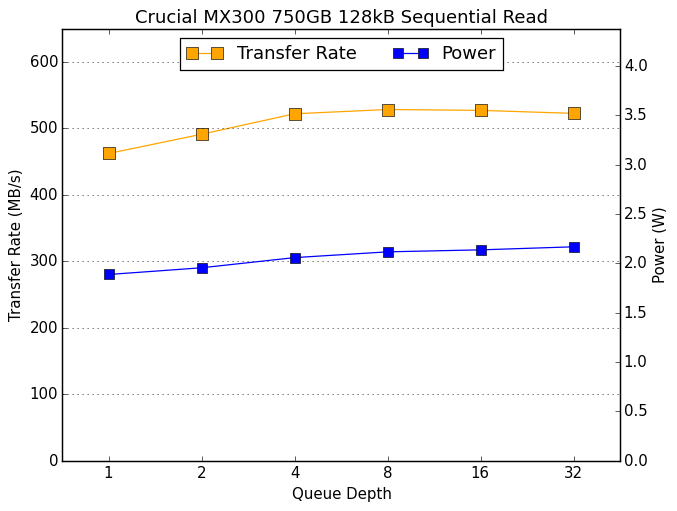 |
|||||||||
With a higher starting point, the MX300's performance scaling is not as pronounced as the MX200's. The MX300 is a little bit slower at higher queue depths.
Sequential Write Performance
The sequential write test writes 128kB blocks and tests queue depths ranging from 1 to 32. The queue depth is doubled every three minutes, for a total test duration of 18 minutes. The test spans the entire drive, and the drive is filled before the test begins. The primary score we report is an average of performances at queue depths 1, 2 and 4, as client usage typically consists mostly of low queue depth operations.

Sequential write speeds on the MX300 are much slower than the MX200 or any other MLC drive, but it does manage to come out ahead of all the planar TLC drives.
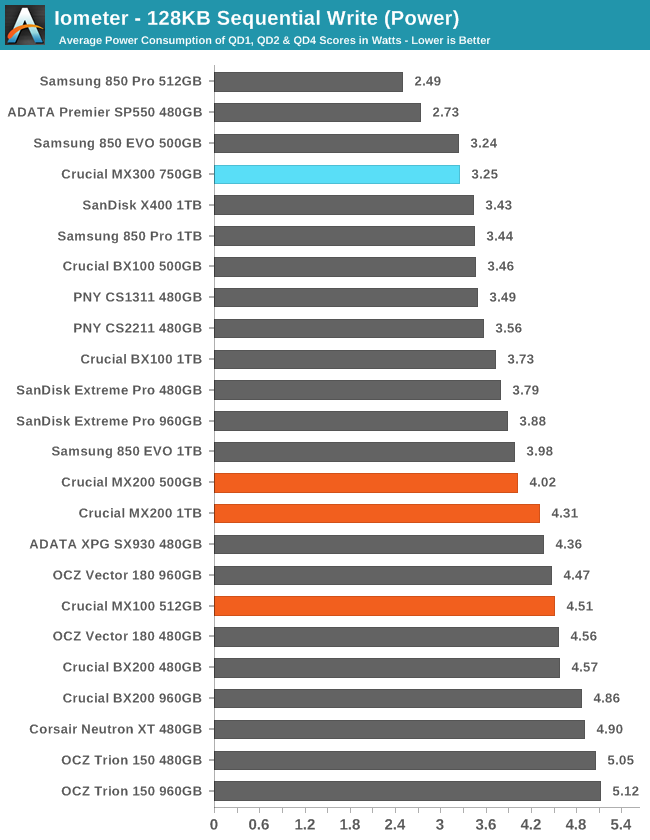
Power efficiency is still great by planar TLC standards, but the Samsung 850 EVO managed to saturate the SATA connection while using the same amount of power.
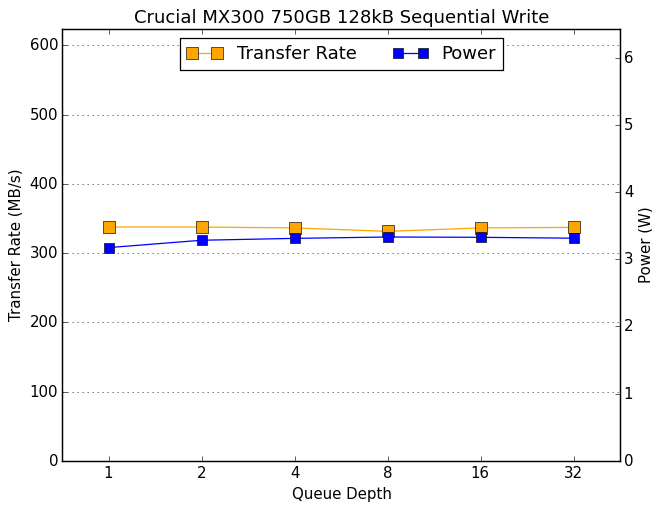 |
|||||||||
The MX300 shows essentially no scaling with queue depth. For this test we usually don't see much scaling as caching large writes allows for full performance even at low queue depths, but full performance for the MX300 is still disappointing.










85 Comments
View All Comments
PVG - Sunday, July 3, 2016 - link
Does anyone know the cell size of Micron's 3D TLC?Jimster480 - Tuesday, July 5, 2016 - link
Haha the performance is horrible for the price.Seriously MX200 kills it which means Transcend SSD370s kill it too.
Even the crappy X400 kills it.... where is the Ultra II on the list? I'm sure it kills it also.
3D nand sucks.
Weasle - Monday, August 15, 2016 - link
These comments show that people don't understand the durability of this drive. Since it's using the 3D-Nand technology that Samsung first adopted, this drive has a better durability rating than a Samsung 850 Pro. Like holy shit.. It uses TLC memory too! It's a TLC drive that's more durable than a MLC drive. It's also a very good priced drive. from $0.26 to $0.24.. That's amazing pricing lol. I don't fucking know why people are complaining.ZapNZs - Monday, September 12, 2016 - link
3D-NAND for the lulz'ers?...I can coat a turd with 24k gold, but at the end of the day it's still crap. And this sure is crap...shame on you Crucial! Given this is [by design] an inferior product to the MX-200, they should have named it something other than the MX-300. TLC has inferior endurance, inferior real-world write performance, and inferior error correction capability. So here we have another TLC drive that is priced almost as high as Transcend's 370, but the 370 uses MLC...MADE FROM MICON'S OWN PREMIUM NAND SUPPLY. Don't count on this drive to give anywhere near the reliability or longevity of the venerable MX-200. This is like changing movie night up from The Godfather to Freddy Got Fingered. Yay Micron!TimAhKin - Friday, November 25, 2016 - link
Got this just now for £100. I think that for this price it's a really good deal.